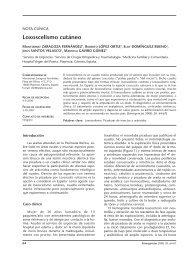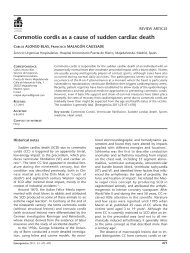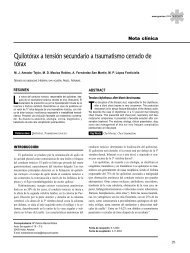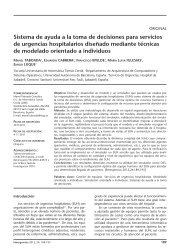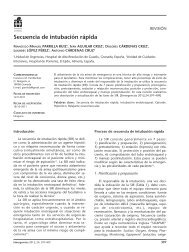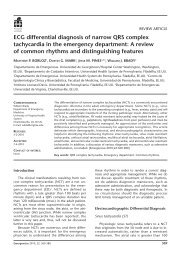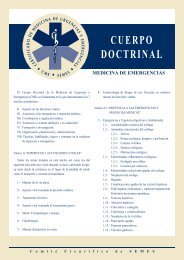Traumatic Intercostal Pulmonary Hernia - Semes
Traumatic Intercostal Pulmonary Hernia - Semes
Traumatic Intercostal Pulmonary Hernia - Semes
You also want an ePaper? Increase the reach of your titles
YUMPU automatically turns print PDFs into web optimized ePapers that Google loves.
LETTERS TO THE EDITOR<br />
Figure 1. Transesophageal echocardiography. Panel A: Systole. Thrombus in the appendage which protrudes into the left atrium.<br />
Panel B: Diastole. The thrombus passed through the mitral ring and appears in the left ventricle. AI: left atrium; OAI: left atrium appendage;<br />
VI: left ventricle; Tr: thrombus. VM: mitral valve.<br />
References<br />
1 Nogué Bou R. La ecografía en medicina de urgencias: una herramienta<br />
al alcance de los urgenciólogos. Emergencias. 2008;20:75-7.<br />
2 García Martín LA, Campo Linares R, Rayo Gutiérrez M. Pericarditis<br />
purulenta: diagnóstico ecográfico precoz en el servicio de urgencias.<br />
Emergencias. 2008;20:135-8.<br />
3 New ACC/AHA/ESC Guidelines for the managemnet of atrial Fibrillation:<br />
Highlghting Stroke Prevention. Nueva York: Medscape Cardiology;<br />
2006.<br />
4 García Quintana JA, González Morales L, Castro Bueno N, Medina<br />
Fernández-Acytuno. Tromboembolismo pulmonar con trombo móvil<br />
e la aurícula. Med Intensiva. 2006;30:183-6.<br />
5 Gómez R, Penas, JL, Fleitas C, Cascallana JE. Trombo libre en aurícula<br />
izquierda. Biomédica. 2005;25:293-4.<br />
6 Alexis Llamas J. Papel de la ecocardiografía convencional y transesofágica<br />
en la fibrilación auricular. Rev Col Cardiol. 2007;14(Supl.<br />
3):165-70.<br />
Rubén GÓMEZ IZQUIERDO 1 ,<br />
Lorenzo ALONSO VEGA 2 ,<br />
Íñigo GÓMEZ ZABALA 3 ,<br />
Carlos TEJA SANTAMARÍA 4<br />
1<br />
Servicio de Cardiología. 2 Servicio de Urgencias.<br />
3<br />
Médico de Familia. Hospital de Laredo. Cantabria, Spain.<br />
Subacute headache in a young woman<br />
normal neurologic signs<br />
Sir,<br />
LHeadache is a frequent reason for consultation<br />
in the emergency department 1-3 , and for daily<br />
practice it is important to differentiate between<br />
potentially dangerous causes and those which are<br />
not. In addition to the ever-important medical<br />
history, we must rely on neurologic examination<br />
and imaging techniques 4,5 .<br />
MWe present the case of a 34 year-old woman with<br />
progressive headache of four days duration, holocraneal<br />
location and oppressive, which increased throughout<br />
the day, with periods of remission and unrelated to the<br />
Valsalva manoeuvre. She reported no vomiting or fever.<br />
She had suffered two spontaneous miscarriages in the<br />
previous five years. Physical examination and neurological<br />
examinations were unremarkable. Laboratory tests<br />
and chest X-ray were normal, with negative pregnancy<br />
test. Computed tomography (CT) scan revealed a<br />
hyperdense image in the right transverse and sigmoid<br />
venous sinuses (Figure 1). Nuclear magnetic angio-resonance<br />
imaging (MRI) of the skull showed acute thrombosis<br />
of these sinuses. Jugular venous Doppler ultrasound<br />
showed alterations. She received anticoagulation<br />
with intravenous sodium heparin, and later with Coumadin,<br />
with good outcome. Thrombophilia test was<br />
normal [ESR, antithrombin III, D dimer, Protein C, Protein<br />
S, lupus anticoagulant, antibodies, hepatitis B and<br />
C, HIV, RPR, anti-Treponema pallidum, anticardiolipin<br />
and antinuclear antibodies (Ab), vitamin B12, folic acid,<br />
serum ferritin, immunoglobulin (Ig) A, G and M, plasma<br />
homocysteine, TSH, B2-microglobulin, V-Leiden gene<br />
factor and prothrombin mutation 202 106], so that<br />
the patient was finally diagnosed with idiopathic cerebral<br />
venous thrombosis (CVT).<br />
LCVT is an underdiagnosed entity that may<br />
affect patients at any age, and both the clinical<br />
picture and neuroimaging techniques show great<br />
variability, which makes the diagnosis a real<br />
challenge 2,3 . CT is the first test to be performed<br />
since it allows ruling out other causes as well as<br />
showing the underlying source; 80% will be abnormal,<br />
but CT findings are not always diagnostic.<br />
MRI is the technique of choice: MR venography<br />
increases the sensitivity of the study,<br />
Emergencias 2010; 22: 154-160 157



